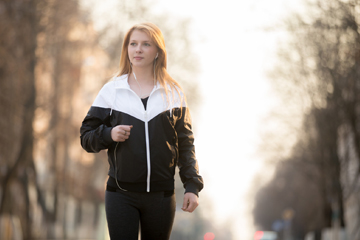 Inactivity is a potential cause for many preventable conditions, such as heart disease and obesity. So, to not be an inactive person and to lose weight, start with a walking program. Walking regularly can help improve fitness levels. Along with many potential health benefits, walking is also one of the easiest and most effective ways for weight loss. It’s low-impact, easy to fit into a busy schedule and accessible for almost any age or fitness level.
Inactivity is a potential cause for many preventable conditions, such as heart disease and obesity. So, to not be an inactive person and to lose weight, start with a walking program. Walking regularly can help improve fitness levels. Along with many potential health benefits, walking is also one of the easiest and most effective ways for weight loss. It’s low-impact, easy to fit into a busy schedule and accessible for almost any age or fitness level.
Generally, calorie-burning cardio exercises help in losing weight and many health experts recommend brisk walking as a calorie-burning cardio exercise for those who are looking to lose weight. A Medical News Today article mentions a Journal of Exercise Nutrition and Biochemistry study that showed the positive effects that walking could have on burning fat and reducing waist circumference in obese females. The women walked between 50-70 minutes 3 days per week for a total of 12 weeks. After the study, they found that the participants lost an average of 1.5% body fat and 1.1 inches around their waists.
Though walking provides benefits, there are certain things a person can do to increase these benefits while walking. So before you lace up your walking shoes and hit the road, follow the below mentioned tips:
- Always warm up before starting walking: Warming up and cooling down before and after walking can prevent muscular stiffness and injury. The best warm-up before walking is to walk slowly, gently stretch your leg muscles and then gradually increase speed. Likewise, a gradual cool down is also recommended after a brisk walk.
- Increase your pace: To burn more calories, it’s better to walk briskly instead of slowly. Increasing your pace is one way to get the heart pumping and burn more calories. In addition to picking up pace, researchers at Ohio State University also found that varying the walking speed during your workouts can help you burn up to 20% more calories than maintaining a steady pace(blog.myfitnesspal.com). So, aim for a brisk walk of 30 to 90 minutes most days of the week. You can walk more on some days and less on others, but the total time for the week should be at least 150 minutes (2.5 hours).
- Walking uphill: Regular uphill walking increases calorie burn and also helps you build muscle in the lower body, which can speed up your metabolism. If you cannot find outdoor uphill areas nearby, and are completely relying on treadmill walking, then you can increase your treadmill gradient and walk. Aim to walk up hills, stairs, or inclines two to three times a week for better weight loss results.
- Choose the Right Gear: Pay attention to the fit and quality of shoes you wear. Invest in good shoes that support your heel when walking and prevent wobbling.
- Aiming for more steps each day: According to The National Center for Biotechnology Information study, taking 10, 000 steps, (which is roughly 5 miles of walking) per day are ideal. If a person can take more steps beyond their normal daily step count, then it would help them lose weight. Avoid elevators and instead take the stairs to encourage walking. You can also walk more by parking further away from the door at shops, work, or school.Also, consider taking walking breaks at work instead of sitting in a break room.
- Maintain form and posture: It is very important to maintain form and posture while walking. A good walking posture allows you to take full breaths, engage your core muscles, and use your leg and buttock muscles for a natural walking stride. It can help you build strength and keep you injury free so that you can continue your walking program.
- Include strength and resistance training: As said before, you don’t have to take a long walk; you can take a break in between and include strength and resistance training in your program. This way, you can make the walking routine more interesting. Body weight exercises helps in strengthening your muscles and burn more calories. Similarly, you can try adding in resistance training during walking to help burn more calories and increase the growth of new muscle. Some exercises to try include: squats, pushups, burpees, or squat thrusts, triceps dips and lunges.
- Swing your arms: Swing your arms faster to increase your pace and your legs will automatically follow it. This will also work your upper body and burn up to 10% more calories when compared to a normal arm swing.
- Make your walking enjoyable: Walk with a friend or a group of friends, walk at a brisk and steady speed while enjoying their company. Walking with a companion or taking a new route now and then can make the activity more enjoyable.
- Doing three shorter walks a day:Even though longer walks have more benefits, shorter and more frequent walks are also beneficial. It is suggested to take three 20-minute-walks instead of a long-stretch walk. In fact, you can take a walk after each meal, as it helps in controlling blood sugar levels and is better than taking a long 45-minute walk once in a day.
Walking can be included in your routine exercise schedule to relax after a busy day or to help you achieve your weight loss goals.